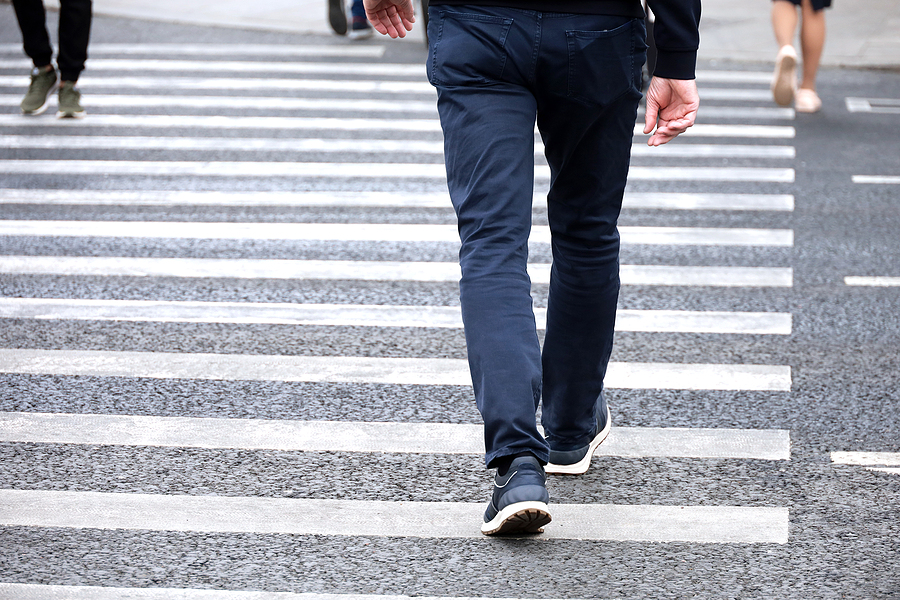Pedestrian accidents will typically result in the person on foot suffering a catastrophic injury. In many instances, this type of accident can lead to tragedy. A pedestrian can be at risk no matter where they’re taking a walk, whether it’s a school zone, a parking lot, or just taking a stroll in their neighborhood. But can pedestrians cause accidents? Can they be liable for a vehicle striking them?

Whenever a pedestrian is hit by a car, most people automatically assume the driver is at fault. Most of the time, that’s the case. But there are others where the pedestrian either contributes to the accident or they’re the main cause. If you’ve been struck by a car and hurt, or you’re the driver who has hit someone walking, an attorney with Sand Law may be able to help. We’ll investigate the accident, gather all of the facts, and then work to help you get as much compensation as possible.
Contact us online or call 651-291-7263 for a free, no-obligation case review.
Common Causes of Pedestrian Accidents
Again, most of the time, the driver is to blame for a pedestrian accident. Some of the more common reasons include the following:
- Distracted driving – Even a momentary loss of focus when behind the wheel can have devastating results. Answering or sending a text, reading an email, having a conversation, or even changing radio stations can result in a car striking a pedestrian.
- Drunk driving – Driving under the influence of alcohol or drugs also causes the driver to lose focus. But they will also not be able to react quickly enough to something unexpected, such as a person unexpectedly walking in the car’s path.
- Reckless driving – There are some drivers who are so angry when behind the wheel that they couldn’t care less if someone is crossing the street in front of them.
- Bad weather – Drivers will sometimes fail to account for weather conditions when they’re on the road. They may, for example, drive too fast on icy roads, and they’re unable to stop as a result. This could be fatal for any pedestrian unfortunate enough to be in the way.
What if a Pedestrian is Under the Influence?
But a pedestrian accident isn’t necessarily always the fault of the driver. A pedestrian who is drunk or high can make erratic decisions, such as stepping into the path of an oncoming car. If the driver can’t see that person, they won’t be able to avoid them.
What if a Pedestrian isn’t Wearing Reflective Material at Night?
Pedestrians should always wear clothing with reflective material when they’re out and about after the sun goes down. This can help a driver see someone walking from a long distance, so they are aware the person is there and can avoid any potential tragedy. Wearing a jacket, a sash, or even shoes or an armband that reflects can make the difference between life and death.
What if a Pedestrian Walks into the Street Without Looking?
Just like drivers can be distracted by their phones, pedestrians can be just as distracted. Some people just can’t bear to not look at their phones nearly every waking movement of the day – even when they’re taking a walk. When they’re so oblivious to their surroundings that they walk in front of a moving vehicle and they’re injured. As a result, they may very well be responsible for paying for not only their own medical bills but also any damages the driver of the car may incur.
Distractions such as phones can cause pedestrians to make serious mistakes. They might fail to use the crosswalk or not use an available sidewalk.
Understanding Modified Comparative Fault
It can be difficult in some instances to assign 100% of the fault to one party or the other when a pedestrian accident takes place. There are some instances where both the pedestrian and the driver will share the blame.
Minnesota is known as a “modified comparative negligence” state. That basically means that when one party isn’t clearly at fault, the parties involved both bear responsibility. This will have a significant impact on the amount of compensation they may be able to receive.
For example, suppose the driver was speeding at the time they hit the person walking. However, the pedestrian was impaired and accidentally stumbled into the vehicle’s path. A judge assigns 50% of the blame to both the driver and the pedestrian. If this is the case, neither of them will be able to take legal action to obtain compensation.
But what if the driver was drunk, and the pedestrian was distracted? The drunk driver may be assigned 80% of the blame and the pedestrian the other 20%. In this case, the pedestrian’s compensation will be subtracted by that 20%. If their damages came to $100,000, they would lose $20,000, leaving them with $80,000.
Will I Still Receive Compensation if I’m At-Fault?
No. If you’re assigned most of the blame, you won’t be eligible for compensation. But if you truly believe you shouldn’t receive any of that blame, much less the majority of responsibility, you’re going to need to prove your case.
The only way to do this will be to hire an attorney. A legal representative can investigate your accident and determine exactly what happened. If the facts produced by that investigation indicate you should be compensated, your attorney will work to help you get what you deserve.
Contact Sand Law Today to Have Your Questions Answered
The pedestrian accident attorneys with Sand Law have a great deal of experience helping clients get the money they have coming to them for the suffering they’ve experienced. We have the skill, resources, and knowledge needed to thoroughly investigate an accident and find out who is responsible.
Once we do that, we’ll demand equitable compensation from the at-fault party’s insurer. Most of the time, we’ll be able to procure a fair settlement. But if that’s not forthcoming, we’ll be ready to fight for our client’s rights in a court of law.
Please give us a call at 651-291-7263 or use our online form for a free consultation.

